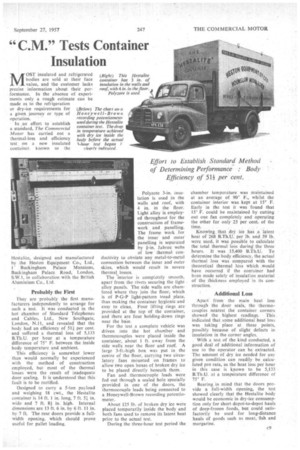" C.M." Tests Container Insulation
Page 47

If you've noticed an error in this article please click here to report it so we can fix it.
MDST insulated and refrigerated bodies are sold at their face In an effort to 'establish a standard, The Commercial Motor has carried out a thermal-loss and efficiency test on a new insulated container, known as the
Hestalite, designed and manufactured by the Heston Equipment Co., Ltd., I' Buckingham Palace Mansions, Buckingham Palace Road, London, S.W.1, in collaboration with the British Aluminium Co., Ltd.
Probably the First
They are probably the first manufacturers independently to arrange for such a test. It was conducted in the hot chamber of Standard Telephones and Cables, Ltd., New Southgate, London, N.I1, and revealed that the body had an efficiency of 51i per cent. and suffered a thermal loss of 5,133 B.Th.U. per hour at a temperature difference of 75° F. between the inside body temperature and ambient.
This efficiency is somewhat lower than would normally be experienced with the method of construction employed, but most of the thermal losses were the result of inadequate door sealing. It is understood that this fault is to be rectified.
Designed to carry a 5-ton payload and weighing 18 cwt., the Hestalite container is 14 ft. 1 in. long, 7 ft. 51, in. wide and 7 ft. 8.1 in. high. Internal dimensions are 13 ft. 6 in. by 6 ft. 11 in. by 7 ft. The rear doors provide a fullwidth opening, which should prove useful for pallet loading.
Polyzotc 3-in. insulation is used in the walls and roof, with 4 in. in the floor. Light alloy is employ ed throughout for the construction of frame work and panelling.
The frame work for the inner and outer panelling is separated by 4-in, Jabroc webs of low thermal con ductivity to obviate any metal-to-metal connection between the inner and outer skins, which would -result in severe thermal losses. .
The interior is completely smooth, apart from the rivets securing the light alloy panels. The side walls are cham fered where they join the floor, which is of P-G-P light-pattern tread plate, thus making the container hygienic and easy to clean. Four lifting rings are provided at the top of the container, and there are four holding-down rings near the base.
For the test a complete vehicle was driven into the hot charriber and thermocouples were placed inside the container, about 1 ft. away from the side walls near the floor and roof. A large 3-ft.-high box was put in the centre of the floor, carrying two circulatory fans mounted on frames to allow two open boxes of broken dry ice to be placed directly beneath them.
Fan and. thermocouple leads were fed out through a sealed hole specially provided in one of the doors, the thermocouple leads being connected to a Honeywell-Brown recording potentiometer.
About 125 lb. of broken dry ice were placed temporarily inside the body and both fans used to remove its latent heat prior to the actual test.
During the three-hour test period the chamber temperature was maintained at an average of 90° F., whilst the container interior was kept at 15° F. Early in the test it was found that 15° F. could be maintained by cutting out one fan completely and operating the other for only 25 per cent. of the time.
Knowing that dry ice has a latent heat of 268 B.Th.U. per lb. and 59 lb. were used, it was possible to calculate the total thermal loss during the three hours. It was 15,400 B.Th.U. To determine the body efficiency, the actual thermal loss was compared with the theoretical thermal loss which would have occurred if the container had been made solely of insulation material of the thickness employed in its construction.
Additional Loss
Apart from the main heat loss through the door seals, the thermocouples nearest the container corners showed the highest readings. This indicated that some additional heat loss was taking place at these points, possibly because of slight defects in insulation in the corner angles.
With a test of the kind conducted, a good deal of additional information of use to the operator can be extracted. The amount of dry ice needed for any given condition can readily be calculated pro rata, as the heat loss per hour in this case is known to be 5,133 B.Th.U. at a temperature difference of 75° F.
Bearing in mind that the doors provide a full-width opening, the test showed clearly that the Hestalite body would he economic in dry-ice consumption only for short depot-to-depot hauls of deep-frozen foods, but could satisfactorily he used for long-distance hauls of goods such as meat, fish and margarine,












































































































